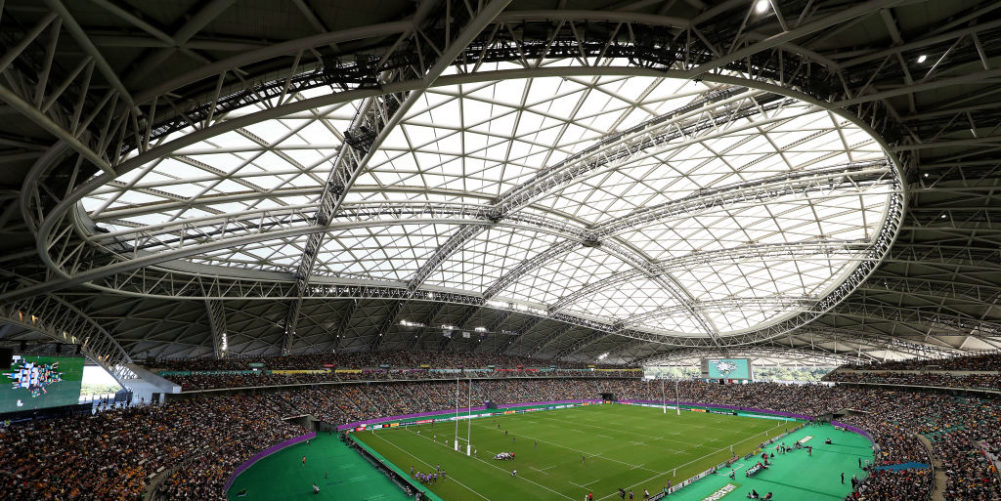WE are heading into the ‘Dome Zone' at the 2019 World Cup, and it could lead to strife. It could mean two quarter-finals being played in steaming temperatures under the closed roof in Oita, while the remaining two are played under the open sky at the Tokyo Stadium.
While the two knock-out games in Tokyo will also be played in humid conditions, the fact that the air is circulating more easily inside the stadium will make the conditions more benign than they will be in the Oita oven, where New Zealand played Canada in midweek.
There has been so much that has been positive about Japan hosting the tournament, and the praise has rightly been fulsome, but the humidity is a problem – and it is one that cannot simply be airbrushed away.
The number of handling errors because humidity makes the ball as slippery as an oil slick has gone through the roof in Japan, and catching it has been made even more difficult when the retractable roofs in the Oita, Kobe, Sapporo Dome, and City of Toyota stadiums are shut.
England are not a team known for coughing-up possession easily, but in their first two matches in Turkish bath conditions against Tonga at the Sapporo Dome, and then the the same in Kobe when they played the USA, they spilled the ball 33 times.
In UK-based Test matches that figure would drop to seven or so per match, which means about 15 handling errors over two matches, as opposed to double that in Japan.
If England's experience does not persuade you that something has gone badly awry, then the uncharacteristic rash of errors by New Zealand in their match against Canada almost certainly will.
The stats log tells us that the back-to-back world champions, who are recognised widely as the best running-handling side on the planet, made nine handling errors in their big opening game against South Africa under the Yokohama sky.
By contrast, when the All Blacks played Canada, who are ranked 22nd in the world, under the closed roof in Oita, they turned over the ball 24 times, including 12 handling errors.
The most spectacular of these involved two of the Barrett brothers – Scott and Beauden – in a match in which younger brother Jordie also started, with each scoring a try in the 63-0 New Zealand victory.
The first glitch came just after the half-hour when Scott raced to the Canadian line with not a red-shirted tackler in-sight. However, as the New Zealand lock dived to ground the ball it slid out of his grasp and rolled forward.
Then, on full-time, it was the turn of his brother Beauden, New Zealand's backline impresario, to end up with egg all over his face. It came when the gifted playmaker, who started at full-back again, cut loose from 70 metres out – but, with only five metres to go, and the Canadian posse left behind, he spilled the ball when a touchdown should have been a formality.

Barrett broke into a broad grin, which he was probably entitled to given that New Zealand had just put 60 points without answer on Canada.
Another explanation could be that Barrett knew something that others had not considered fully – which is that the All Blacks will not play under a closed dome again this tournament.
On the other hand, should England and Wales qualify for the quarter-finals, they will be heading back to the Oita sweat-shop. Wet conditions anywhere are a great leveller, but the extreme difficulty in handling effectively in Japan's Dome Zone stadiums, accentuates the lottery element considerably.
All Black captain Kieran Read explained why. “It was bloody tough in this humidity under this roof. We were all quite slippery…we were dripping wet, even before kick-off…things to work on, but in these conditions it's tricky.”
While there is no chance of the quarter-final venues being swapped for others at this stage, if England qualify coach Eddie Jones should canvass strongly for World Rugby to keep the roof open in Oita for their quarter-final.
Rugby Union has a time-honoured tradition of being an open-air game in which adapting to the elements astutely is part of the challenge. Unless very serious weather conditions make that untenable – like metres of snow, freezing fog, or a day-long tropical storm – the roof should be open.
Closing the roof of a stadium in a country with such high humidity is the equivalent of putting a lid on a saucepan which is already on the boil. That's alright for cooking frozen peas, but not for a World Cup quarter-final.
Even so, with Wales almost certain to play in Oita, Warren Gatland faces a dilemma. The outgoing Wales coach has pushed hard to allow the Welsh first call on whether the roof at the Principality Stadium is open or closed for internationals – and Gatland prefers it shut.
My view is that it would be a big
mistake to bin the game's traditions to accommodate one coach, irrespective of his success. The World Cup roof debate also raises the question of consistency.
Will Gatland insist that the Oita roof remains shut if there is a danger his Welsh side could wilt in the heat? Or will he back his oven-hot Turkish training camp and post a “Welcome to the Pleasuredome” message to their opponents?


























